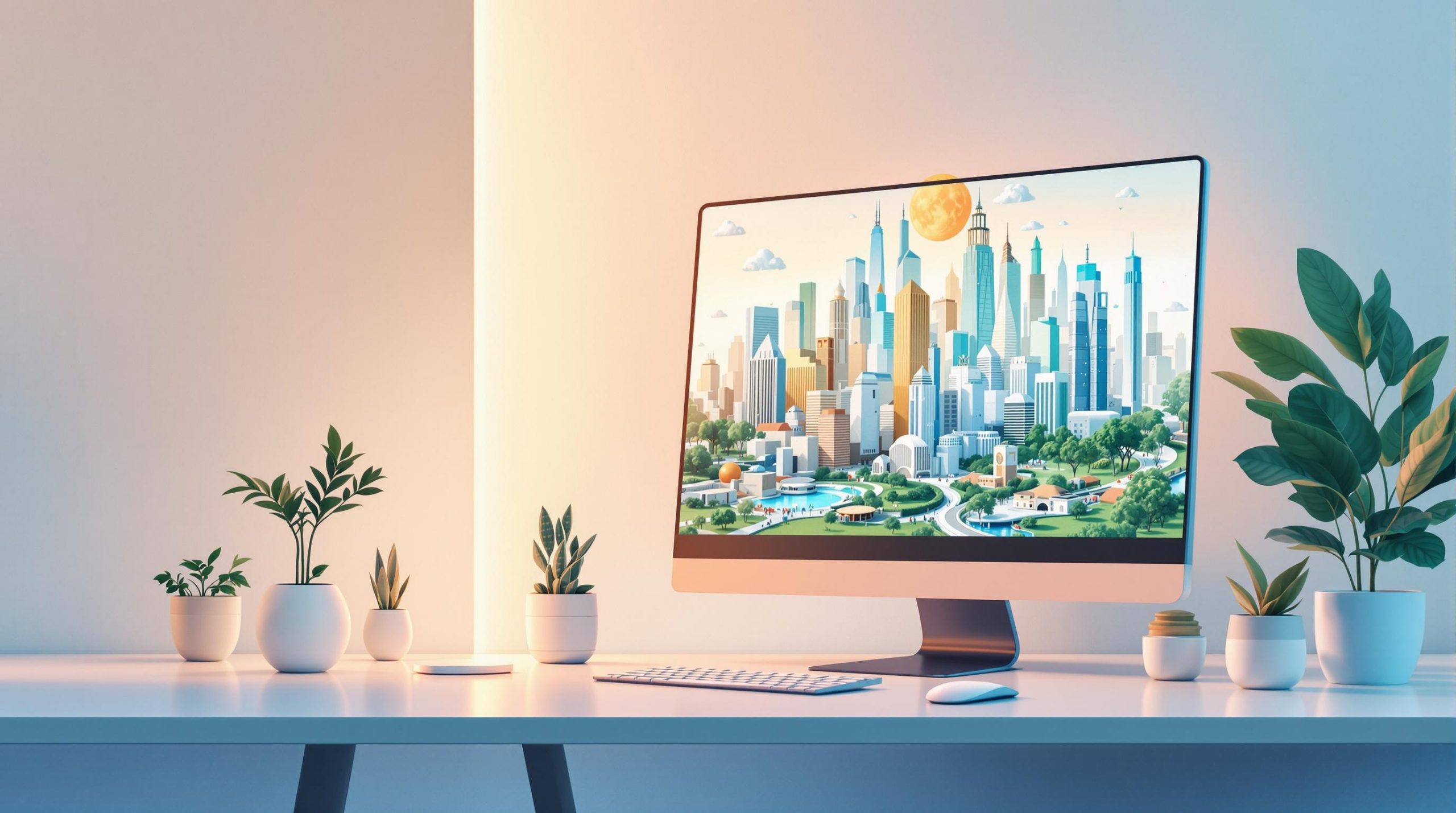AI is changing how 3D scenes are created. It speeds up workflows, automates repetitive tasks, and allows artists to focus on design instead of technical details. Key advancements include:
- Generative AI: Quickly creates 3D assets and environments from prompts.
- Language-to-Scene Tools: Build 3D scenes using natural language descriptions.
- AI-Driven Optimization: Enhances performance by refining models, lighting, and resources.
- Procedural Generation: Generates flexible, dynamic environments.
- Real-Time Editing: AI agents enable instant scene adjustments.
These tools simplify 3D creation, making it faster and more accessible while maintaining quality. For example, NVIDIA‘s platforms like Edify and Omniverse integrate AI to generate, optimize, and edit scenes efficiently. While challenges like data quality and computational demands remain, AI continues to improve workflows across industries such as gaming, architecture, and virtual production.
Related video from YouTube
Key AI Technologies for Real-Time 3D Scene Building
Real-time 3D scene building has been revolutionized by AI technologies that simplify and speed up the creative process. These tools are changing how artists and developers design and optimize their work.
Generative AI for 3D Asset Creation
Generative AI is a game-changer for creating 3D assets in real-time projects. Platforms like NVIDIA’s Edify make it possible to generate detailed 3D environments and assets in just minutes. This includes producing intricate 3D meshes and high-dynamic range images (HDRi) for lighting and backgrounds [1].
By automating the creation of textures, environments, and background elements, generative AI drastically cuts down production time. Instead of spending hours or days on asset creation, artists can now focus more on refining their creative ideas.
While generative AI handles asset creation, tools like language-to-scene technology take care of assembling these elements into complete environments.
Language-to-Scene Tools
Language-to-scene tools make it easier for anyone to create 3D environments, even without technical expertise. For example, SceneScript allows users to build detailed 3D scenes by simply describing them in natural language. At SIGGRAPH 2024, NVIDIA showcased how their AI could turn a text description of a desert landscape into a fully developed 3D environment in just five minutes [1].
These tools bridge the gap between concept and execution, making scene creation faster and more intuitive. But creating the scene is only part of the process – optimization is just as crucial.
AI-Driven Asset Optimization
After assets and scenes are built, AI ensures they’re optimized for real-time performance. This includes tasks like compressing models, fine-tuning lighting, and managing resources to maintain quality without sacrificing performance.
This approach has proven especially useful in industries like architectural visualization, where it improves output quality while reducing the workload for designers [3].
These AI tools are not just theoretical – they’re actively transforming workflows across industries. They allow creators to achieve better results in less time while meeting the performance demands of real-time applications.
sbb-itb-5392f3d
Workflows for AI-Enhanced Scene Building
Modern AI tools are changing the game for real-time 3D scene creation. Here’s a closer look at workflows that make the most of these advancements.
AI for Procedural Scene Generation
AI-driven procedural generation is all about creating dynamic environments that can change based on specific needs. Unlike traditional generative AI, which produces static assets, procedural generation allows for flexible scene creation that adapts to evolving parameters. For instance, NVIDIA Edify lets artists set scene parameters, use AI to generate foundational environments, and fine-tune results using optimization tools [1].
Another example is World Labs‘ AI system, which transforms single images into interactive 3D scenes. This approach speeds up environment prototyping and allows creators to quickly move from concept to production [2].
AI Integration with Universal Scene Description (USD)
Integrating AI-generated content with Universal Scene Description (USD) simplifies workflows, from organizing assets to ensuring compatibility across platforms. Tools like NVIDIA’s Omniverse USD Composer make it easy to incorporate AI-generated assets into larger production pipelines without disrupting the process [1].
Real-Time Editing Using AI Agents
AI agents bring a new level of efficiency to scene editing, enabling instant changes and smart adjustments. At SIGGRAPH’s Real-Time Live event, AI agents showcased their ability to modify scene elements and rearrange layouts on the fly [1].
"The big promise of these neural scene representations, at the end of the day, is to use them in vision tasks. I give you an image and from that image you create a representation of the scene, and then everything you want to reason about you do in the space of that 3D scene." – Vincent Sitzmann, CSAIL [5]
These AI agents offer several advantages:
- Instant feedback during edits
- Dynamic adjustments to environments
- Ongoing performance improvements
With these tools, real-time editing becomes faster and more efficient, paving the way for even more exciting developments in AI-powered scene building [4][5].
Future Trends and Challenges in AI-Driven 3D Scene Building
Advances in Generative AI
Generative AI tools like NVIDIA Edify are changing the game by enabling quick 3D scene creation from simple prompts. This shift allows creators to focus more on artistic vision rather than technical hurdles. For instance, Light-Field Networks (LFNs) significantly improve rendering efficiency, handling scenes at over 500 frames per second while using just 1.6 megabytes of storage. Compare that to traditional methods, which require 146 megabytes [4][5].
However, these advancements come with their own set of challenges.
Challenges in Training AI Models
AI systems, like those developed by World Labs, face hurdles in achieving physical accuracy and consistency in scene generation [2]. Training these complex 3D models demands immense computational resources. Common issues include inconsistent data quality, which impacts reliability, and ensuring compliance with physics – critical for realism in applications like gaming and simulations. To tackle these, developers are focusing on better data validation systems and integrating physics-based constraints.
Despite these obstacles, AI continues to push the boundaries of what’s possible.
Opportunities for Further AI Integration
Tools like TyFlow simplify complex particle simulations, freeing up artists to concentrate on creative aspects [3]. Intelligent automation is reshaping workflows without compromising creative control. Real-time rendering tools are another game-changer, offering instant previews and error detection. This dramatically cuts down iteration time while boosting the quality of the final output [3]. These advancements underscore how AI is streamlining real-time 3D workflows.
"The big promise of these neural scene representations, at the end of the day, is to use them in vision tasks. I give you an image and from that image you create a representation of the scene, and then everything you want to reason about you do in the space of that 3D scene." – Vincent Sitzmann, CSAIL [5]
Conclusion: AI’s Role in Transforming 3D Scene Building
Key Takeaways
AI is reshaping 3D scene building by speeding up workflows and opening new doors for creativity. With advanced tools, artists can now craft intricate scenes in a fraction of the time it used to take. For example, technologies like Light-Field Networks are making rendering far more efficient. These breakthroughs are changing how professionals approach 3D design, simplifying asset creation, optimization, and scene generation.
By handling technical tasks and freeing up time for creative work, AI is setting a new standard for 3D scene building. The combination of AI with Universal Scene Description (USD) and real-time editing tools has made workflows more efficient, letting creators focus on the artistic side instead of technical details.
Looking Ahead
As AI tools evolve, professionals have a chance to rethink how they work and create. Vincent Sitzmann highlights the potential of neural scene representations:
"The big promise of these neural scene representations, at the end of the day, is to use them in vision tasks. I give you an image and from that image you create a representation of the scene, and then everything you want to reason about you do in the space of that 3D scene." [5]
To get started, try incorporating proven AI tools into your prototyping process and gradually expand their role in your workflow. Platforms like BIFF.ai are great resources for staying updated on the latest in generative AI and its applications in 3D design.
AI is not just a tool – it’s a game-changer that helps creators bring their ideas to life faster and with greater precision.

